F-Gas regulation, e-bus growth and tender specification for e-HVAC systems bodes well for Konvekta’s CO2 heat pump
By Jim Gibbins - 7th March 2023
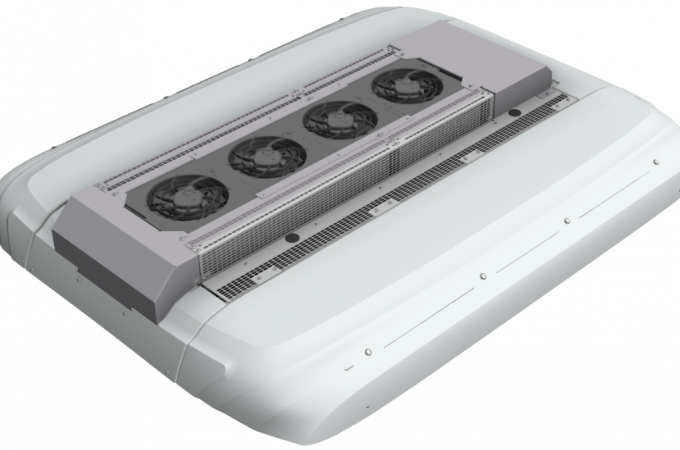
Konvekta's UL700EMCO2 heat pump
Germany - Changes to the F-Gas regulations, growth in the European electric bus market, increasing numbers of electric bus tenders specifying full electric HVAC systems, as well as the environmental benefits, cost and energy efficiency advantages of Konvekta’s CO2 heat pump HVAC system are all contributory factors for growing demand, suggested Reiner Boland, Head of the Bus Division at Konvekta AG in Schwalmstadt, Germany in recent weeks.
In discussion with T&BB, Boland said that more than 2,000 buses had been fitted with its CO2 heat pump HVAC system and these were now in successful operation throughout Europe.
The Konvekta CO2 heat pump HVAC system uses carbon dioxide as a refrigerant, which has a global warming potential (GWP) of 1. Konvekta’s CO2 heat pump uses ‘waste heat energy’ to heat the bus, energy which, in conventional air conditioning systems, would just be exhausted to the atmosphere. The full electric 400V system offers significant energy savings compared with buses using conventional heating systems, because it can generate the heat (water and air) itself needed to heat the interior. This can be done up to an outside temperature of -22°C.
In conventional buses the diesel engine in the bus is most commonly used to send hot water to heat exchangers to enable it to provide the interior with warm air. In electric buses, there is no hot water supplied from the diesel engine because, of course, there is no diesel engine, yet hot water is still needed for the heat exchangers. There are two options to resolve this issue, advised Boland; either use of a small diesel heater, which is now not accepted anymore by almost 95% of the markets, or, use of an electrical heater, which potentially is a significant energy draw on the traction battery, which, ultimately compromises vehicle range.
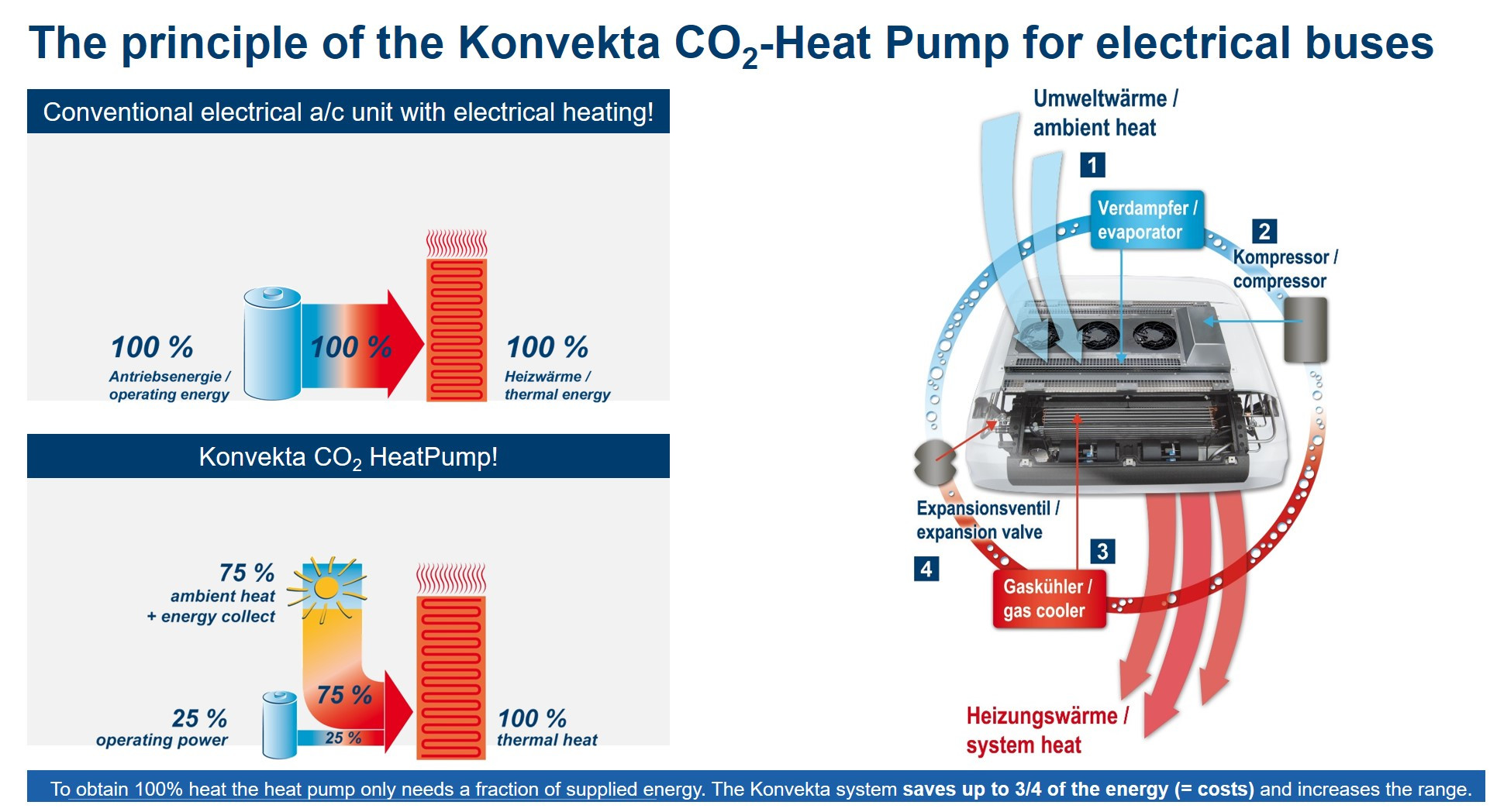
Diagram to show principle of Konvekta's CO2 HeatPump
The heat pump, in the best case scenario, can use 75% of the energy from the ambient air, Boland said. In the winter, for instance, it takes cold air (energy) from the outside and reverses it into warm energy to make hot water and warm air with the heat pump. (In some cases, however, it is still necessary to use an electrical heater). Boland pointed out the heat pump has a Coefficient of Performance (COP) of 4, whereas an electrical heater has a COP of only 1. (So, with an electric heater, to generate one kilowatt of heating energy you must invest in 1kW of electrical energy). An added advantage, as mentioned earlier, of using CO2 as a refrigerant is that it has a global warming potential (GWP) of 1.
In the beginning, Konvekta fitted its CO2 units on conventional diesel buses. But, because of the difference in pressure requirements, 400 volts is needed for operation, it meant that an electric generator needed to be fitted, which added weight and added to energy consumption. The CO2 heat pump today is only offered with electrically powered buses.
F Gas regulation – forcing change, an opportunity for Konvekta
The F-Gas regulation is also likely to have a significant bearing on demand for non-hydrofluorocarbon (HFCs) refrigerants. The F-Gas regulation, which was introduced in 2015 by the European Community is designed to reduce the import and production of F-gases or HFCs from 100% in 2015 to 21% in 2030; this means that the availability of F-Gases for use in all applications (houses, commercial buildings and transport) will reduce, and prices will only get higher. This restriction applies to all vehicles new and used. Now the EU is working to amend the F-Gas regulation further, with plans to reduce the use of HFC gases to 5% in 2030, with legislation expected within the next two years.
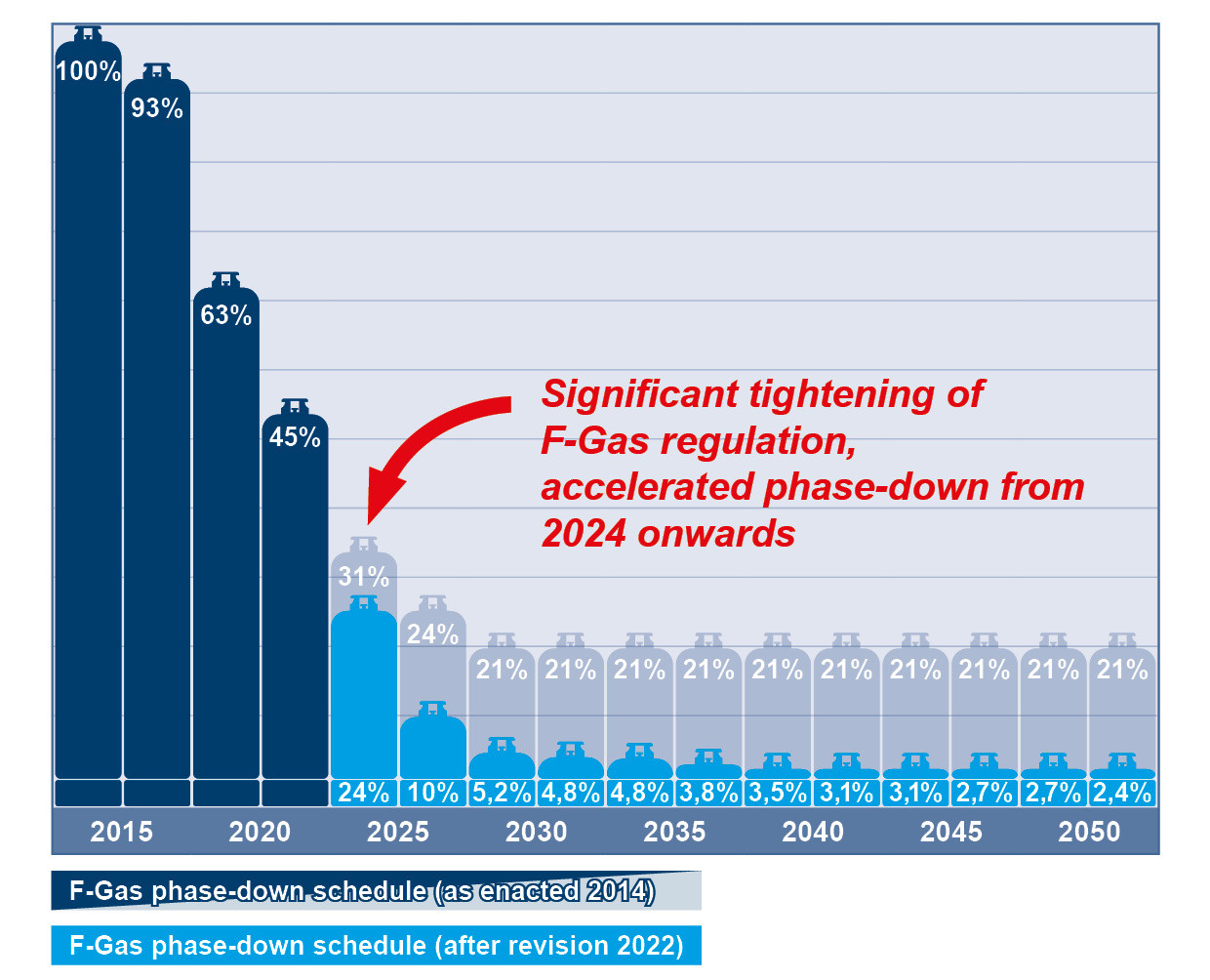
A chart to show the impact of the F-Gas regulation 2015 on available HFC gases in Europe
What does this mean for a bus buyer and operator? Konvekta, said Boland, is constantly trying to remind or educate its customers that by specifying R134a or other conventional refrigerants of today (like R407) they may end up with a big problem in 2030 in finding a refrigerant for their AC units. “Most customers don't even know that this might be a big problem for them.” Without these gases, the HVAC unit simply won’t work! It will also be both difficult and expensive to replace and retrofit a HVAC system with a CO2 heat pump; it will also be most probably economically unviable given the age of the bus.
Markets for the CO2 heat pump
The Konvekta CO2 heat pump was first fitted in a 9-metre and 12-metre bus. The system was then installed into 15m and 18m articulated and then double deck vehicles. The HVAC solution with CO2 heat pump, can also be installed in vehicles up to 24-metres in length.
Konvekta is focussed strongly on the high quality and advanced technology markets of Europe; its current electric bus building customers for the CO2 heat pump include Solaris (single and articulated), Evobus (single and articulated), MCV-Volvo for the UK market (both single and double deck), and Irizar (option for single and articulated bus model, the first vehicle was for an operator in Switzerland).
The company has several projects with new bus building customers including Hess, BYD and Ikarus.
For Carrosserie HESS AG of Bellach, Switzerland, a CO2 heat pump will be fitted sometime in 2023 in both a 12m and 18m buses.
Chinese electric bus builder, BYD Inc of Shenzhen, is another electric bus customer to add to the growing list of European bus builders specifying the Konvekta CO2 heat pump. Boland said that mid-2022 it had started its first project with BYD supplying its CO2 heat pumps for its electrical buses at its factory in Hungary. These buses are destined for Germany, where there is increasing demand from German operators for this technology. Boland added there are an increasing number of tenders of electric buses in the European market specifying the CO2 heat pump because of the cost and environmental advantages of this product.
Another new project is with Hungarian bus builder, Ikarus Electric Zrt. of Székesfehérvár – Konvekta plans to deliver the first prototype CO2 heat pump unit in mid-2023.
Some of the big manufacturers in Europe are only just embarking on building electric buses with volume deliveries starting to happen within the next two years. Within five years, if not sooner, all urban buses will be electric, predicted Boland.
Boland added that there are still many customers in Europe that it does not have currently on its customer list, but which, it plans to target as customers in future; especially those companies where, Boland and the company feels, “there is a good fit,” in the coming years.
Boland stated that Konvekta’s core market focus remains on the MENA region and that it had recently restarted its business with MCV in Egypt. On newcomers (disruptors), each company is evaluated, he stated, and then once discussions have been had, a decision is made on whether to proceed with a project or not.
On other markets Boland said Konvekta’s operation in China today is mainly to source parts from the local market and to maintain the supply chain of quality parts. It continues to supply Scania in China, which is manufacturing some products in China – such as Scania Touring - for export into Europe and Asia-Pacific markets. It does not supply Chinese OEMs for the Chinese market because the bus and coach market in China is completely different with different expectations in terms of product quality and reliability.
Investments – R&D and Warehousing
Prior to the pandemic Konvekta invested in an advanced climate testing centre capable of fitting buses of up to 24 metres in length. It can create temperatures in excess of 50 degrees and minus 20 degrees Centigrade. It is also capable of simulating solar radiation to test buses in these extreme conditions as well as for fine tuning its systems.
Konvekta has also invested a substantial sum in pressure chambers where it makes the final pressure test of up to 160 bars of the CO2 units. (The CO2 units can reach a maximum pressure of 120 bars, but this is the final check – every unit is pressure tested at 160 bar).
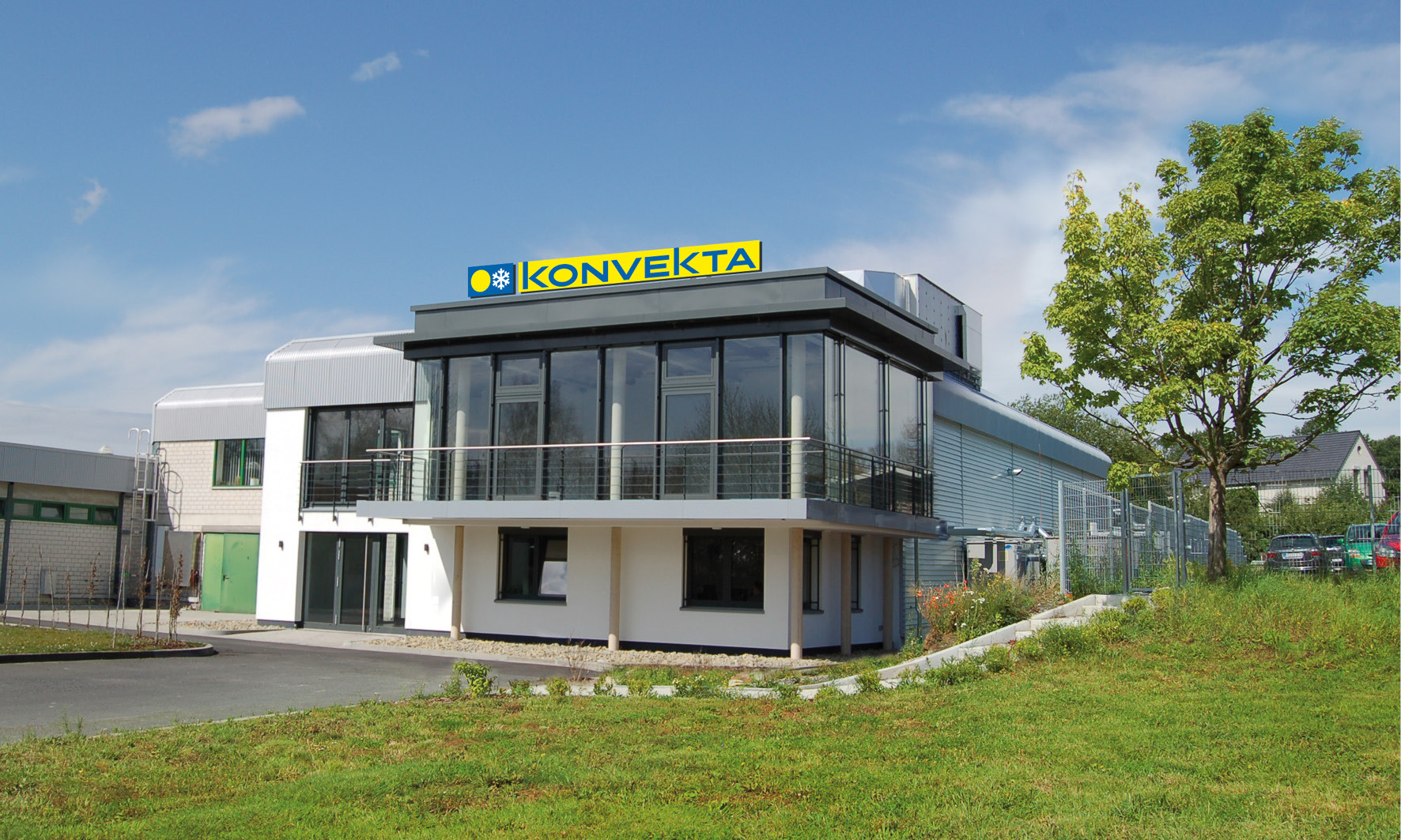
A picture of Konvekta’s CO2 heat pump testing chamber
Another big investment has been in its parts warehouse to secure the supply chain. Over the past two or three years, said Boland, the supply chain has been a big problem. To ensure supply of its systems to all customers in 2022, Konvekta doubled its warehousing capacity for parts – consequently this is the reason for why Konvekta has been a reliable partner over the last two years, it has had few delays in deliveries to customers.
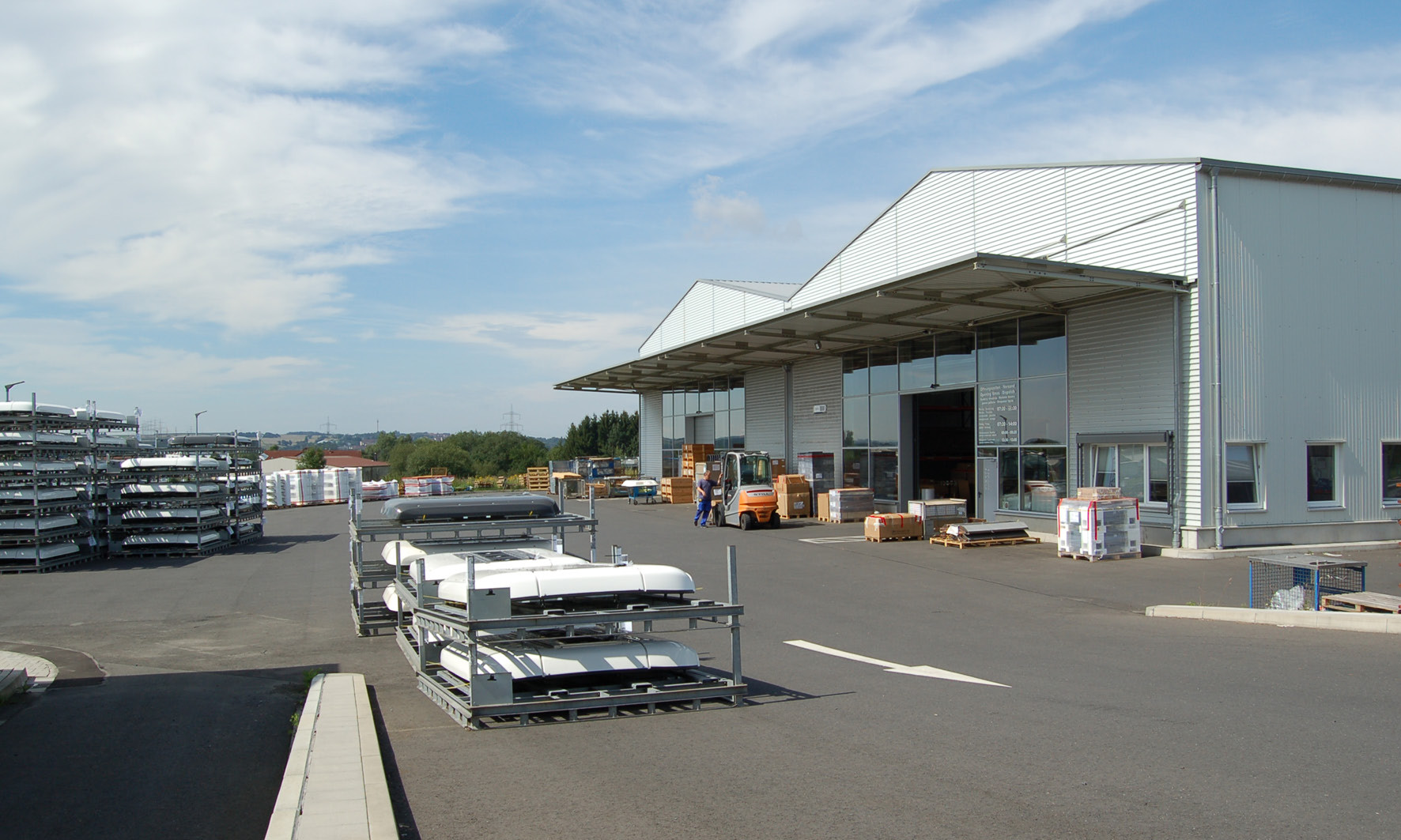
A picture of Konvekta's Parts Warehouse & Logistic Centre
While sales of conventional HVAC systems for diesel and gas powered buses still represents most of the company’s sales, Boland stated that 90% of its R&D was now being spent on its products for electric buses, making its products even better and more efficient. This includes the next generation of products for electric buses to be introduced in the next few year.

